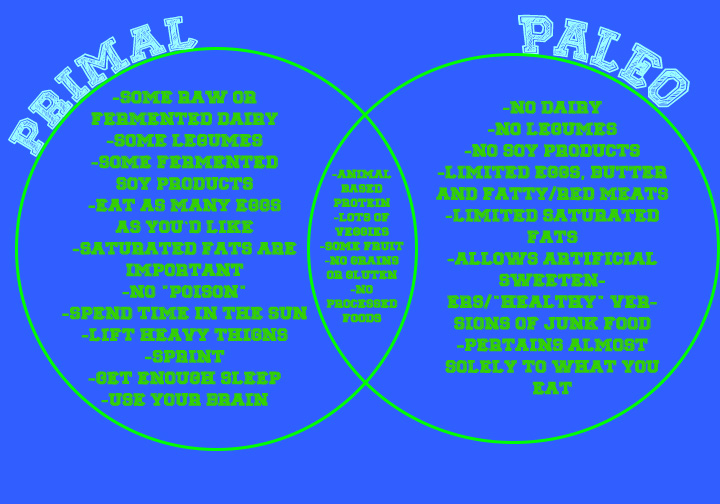
My gym regularly runs nutrition challenges (be sure to check out our awesome Challenge App if you want to get in on a healthy eating challenge this fall) where they encourage members to eat “clean” for a certain period of time — two weeks, thirty days, etc.
However, everyone’s definition of “clean” is a little different. Some people follow strict Paleo plans whereas others choose to follow The Zone templates or even venture out to complete their first Whole30. During our last challenge, I had a friend who said she didn’t like the way the Paleo regime made her feel and instead opted for Primal eating.
I was stumped. How many different ways are there to eat healthy? What on Earth is Primal eating? I set out to find out a little more about this mysterious new way of eating.
If Primal eating sounds like a battle between cavemen, you may be a little bit right, but in reality, it’s very similar to the Paleo program while also taking a more wholistic approach to health, focusing on other facets of wellness outside of the food you eat.
What Is Primal Eating?

Primal eating has much in common with Dr. Loran Cordain’s Paleolithic diet. Both essential center around the act of attempting to eat more like our ancestors did — items that were readily available and easy to scavenge such as fruit, vegetables and animal-based protein.
However, the Primal Blueprint, developed by Mark Sisson, picks up where Paleo left off. It compounds the eating program (with a few key differences such as adding in more saturated fats and completely avoiding “poisons” such as diet soda) with making healthier life choices in every facet of your life for a wholistic and well-rounded approach to human health.
The ten “laws” of the Primal Blueprint include:
1. Eat lots of animals, insects and plants — you’ll notice here that Sisson doesn’t put an emphasis on lean or grass-fed meats.
2. Move around a lot at a slow pace — this law includes doing low-impact exercise like walking, hiking or riding a bike several times a week. Sisson also encourages his followers to go shoeless when given the opportunity.
3. Lift heavy things — Sisson recommends full-body weightlifting (as opposed to isolating muscle groups and body building) two to three times a week with a heavy emphasis on functional movement such as squatting, jumping and lunging.
4. Use your brain — Get creative and be intentional about learning new things
5. Avoid poisonous things — This includes everything from the chemicals in your laundry detergent and shampoo to the pesticides on your food as well as “sugars, grains, processed foods, trans and hydrogenated fats, and mercury in certain fish.” Basically, if whatever you’re eating doesn’t contribute to your overall health, throw it away.
6. Avoid trauma — This may seem like common sense, but part of the Primal Blueprint is not engaging in risky behavior like smoking, doing drugs, drinking alcohol to excess, not wearing a seatbelt, playing in traffic, etc.
7. Get a lot of sleep — You’ve frequently heard from us the important role that sleep plays in your health — you can read more about the dangers of sleep deprivation on your health here. Sisson once again reiterates this.
8. Play — Make it a point to participate in recreation at least once a week
9. Get sunlight every day — Although sunlight has been somewhat demonized in recent years by dermatologist in particular, the truth is that sunlight still plays an important role in our health. You can learn more about sunlight, Vitamin D and the appropriate amount of sun to get each day here.
10. Sprint every couple of weeks — Sometimes you just need to pull a Ricky Bobby and go fast. This is called anaerobic exercise and should be done at least once every other week.
1. Eat lots of animals, insects and plants — you’ll notice here that Sisson doesn’t put an emphasis on lean or grass-fed meats.
2. Move around a lot at a slow pace — this law includes doing low-impact exercise like walking, hiking or riding a bike several times a week. Sisson also encourages his followers to go shoeless when given the opportunity.
3. Lift heavy things — Sisson recommends full-body weightlifting (as opposed to isolating muscle groups and body building) two to three times a week with a heavy emphasis on functional movement such as squatting, jumping and lunging.
4. Use your brain — Get creative and be intentional about learning new things
5. Avoid poisonous things — This includes everything from the chemicals in your laundry detergent and shampoo to the pesticides on your food as well as “sugars, grains, processed foods, trans and hydrogenated fats, and mercury in certain fish.” Basically, if whatever you’re eating doesn’t contribute to your overall health, throw it away.
6. Avoid trauma — This may seem like common sense, but part of the Primal Blueprint is not engaging in risky behavior like smoking, doing drugs, drinking alcohol to excess, not wearing a seatbelt, playing in traffic, etc.
7. Get a lot of sleep — You’ve frequently heard from us the important role that sleep plays in your health — you can read more about the dangers of sleep deprivation on your health here. Sisson once again reiterates this.
8. Play — Make it a point to participate in recreation at least once a week
9. Get sunlight every day — Although sunlight has been somewhat demonized in recent years by dermatologist in particular, the truth is that sunlight still plays an important role in our health. You can learn more about sunlight, Vitamin D and the appropriate amount of sun to get each day here.
10. Sprint every couple of weeks — Sometimes you just need to pull a Ricky Bobby and go fast. This is called anaerobic exercise and should be done at least once every other week.
Other important principals of the Primal Blueprint include the fact that you are not a slave to genetic predisposition, saturated fats and cholesterol are not unhealthy, your body composition is determined by what you eat and exercise is not an effective weight management tool.
The attitude behind Primal Blueprint is also another thing that makes the program unique. For Sisson, Primal eating and living is all about simplifying things, taking the time to enjoy life and being more well-rounded as an individual as opposed to eating to train, trying to break sugar addiction or creating a strictly regimented meal plan. There is a lot of philosophy that goes along with the Primal blueprint that extends beyond the idea of losing weight or being more effective at exercise.
In fact, Sisson himself spent his younger years as a world-class marathon runner and was motivated to create the Primal Blueprint when he discovered at the height of his fitness that he was often sick, injured and just felt bad in general. It was then that he started using his education and extensive athletic experience to build and re-shape the way the world viewed health and nutrition.
How Do I Know If Primal Eating Is Right For Me?
It’s up to each individual to determine what pattern of eating and exercise fits their health needs. However, Primal eating and living can be appealing for several different reasons.
First of all, the Primal blueprint addresses much more than just the way you eat. The concept integrates other aspect of wellness that are just as essential to living your best life as eating well. Secondly, the Primal blueprint, like the Whole30 program, takes a look at and ultimately bans the idea of manipulating a healthy diet plan with artificial sweeteners. However, many Primal desserts are “Paleo” friendly as well and include ingredients like honey, vanilla and various plant-based flour substitutes.
For more information on the difference between the Paleo Diet and the Primal Blueprint, check out this explanation from Sisson.
